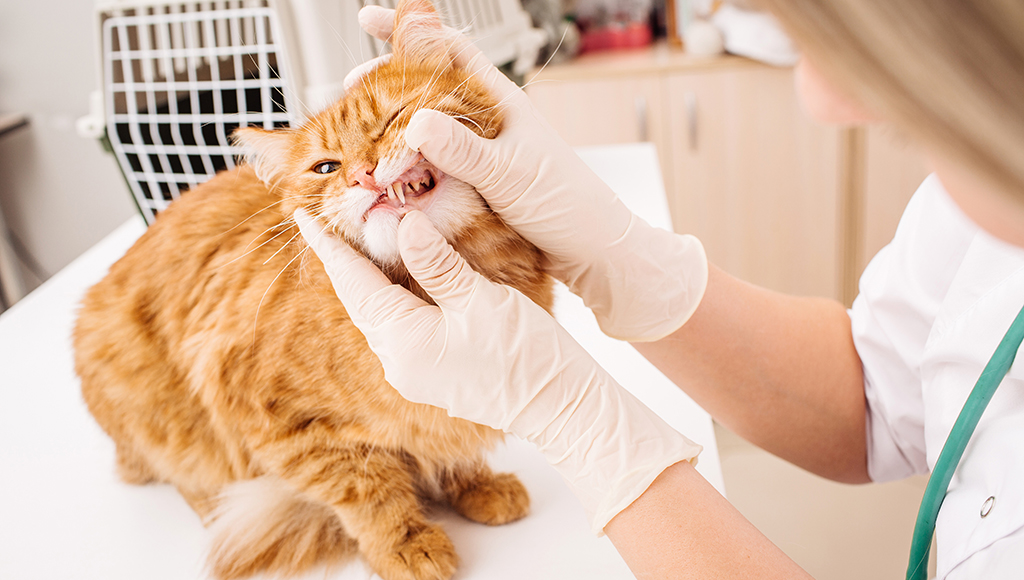February is National Pet Dental Month
Preventing periodontal disease can result in a healthier life for your pet.

Bad breath in a dog is often dismissed simply as "doggy breath." In fact, it may signal periodontal disease, which is the most common ailment suffered by dogs and cats over 3 years old. Preventing periodontal disease can result in longer, healthier lives for pets. To educate owners of this, February has been designated National Pet Dental Month by the American Veterinary Medical Society, and the American Veterinary Dental Society.
Unfortunately, dental care is often ignored by pet owners. On average, only 1 out of every 10 owners makes sure their pets' teeth are cared for. Dental disease, specifically periodontal disease, is the most common ailment affecting pet dogs and cats. Although dogs and cats rarely get cavities, the plaque and tartar that forms can cause gingivitis and periodontal disease which can lead to tooth decay, bleeding gums and tooth loss. The bacteria that causes this can also travel through the bloodstream and eventually damage some major organs.
Halitosis, or bad breath, is the most common sign of oral disease. Classic "doggy breath" is not necessarily normal. The major cause of halitosis is periodontal disease. This is an infection of the gums and other supporting structures of the teeth. Plaque builds up every day on the tooth surface including at the gum line. Left in place, the plaque can mineralize, or harden, in less than 2 days, forming calculus or tartar. The tartar will stick to the tooth surface forming a scaffold for more plaque accumulation. The continued build-up of tartar both above and below the gum line can eventually produce an environment that is a haven for certain types of bacteria that may be more destructive to the periodontal tissues and also produce a more noticeable odor.
Although the most obvious visual clue to dental disease is the build up of the tartar on the tooth surface; a much more subtle clue to dental disease is the change in the normal gum lines. Every tooth has a bulge just where the normal, healthy gum meets the tooth. This bulge is normally not a straight line for most teeth. This means that we should see a slight wave of gums along the outside of normal, healthy teeth. If the gums are straight along the tooth, either gingivitis, or inflammation of the gums, or gingival recession, or loss of the normal gum height, is present.
Gingivitis is reversible, as the inflammation will go away once the cause of the inflammation is addressed. Plaque along the gum line is easily the most common cause of gingivitis. Once the gingiva, or gums, begin to be lost, periodontal disease is present. As in humans, gingival recession is permanent. With gum loss, comes exposure of the root surface of the tooth. The root surface is rougher than the crown of the tooth and is therefore more likely to attract plaque.
In dogs, gum loss has even more serious repercussions than in humans. The area between the roots of teeth with more than one root is called the furcation. The furcation is much closer to the normal gum line in the teeth of dogs. A seemingly small amount of gum loss can cause exposure of the root surface and perhaps even this furcation area, providing even more surface for plaque and tartar on which to adhere. What looks like a black spot along the gum line of a tooth is much more likely to be exposed furcation than a "cavity." Dogs get caries, or "cavities," much less commonly than do humans. Visualization of the actual bulge or even the exposed furcation area of a tooth is evidence of fairly significant periodontal disease. As more of the gums and bone supporting the teeth are lost, the more likely the loss of teeth. Recognizing one of the more severe signs of dental disease, loosening of the teeth, may be tricky unless one knows to look for it.
Some dogs develop red tissue around their gums that seems to grow over the tooth. Usually the tooth enamel under this red tissue is eroded and can be filled once the tissue is removed. If, however, the enamel has eroded to expose the tooth's pulp (nerve and blood supply), the tooth cannot be filled and must be extracted, since it causes pain for the animal. We do not yet know why this enamel erosion occurs, but weekly use of fluoride on the teeth may help prevent the lesions.
The amount and severity of dental disease in our pets can be very surprising. The recognition and treatment of dental disease is all-to-often overlooked by veterinarians and pet owners alike. Most veterinary schools have yet to recognize the importance of teaching about oral health in the education of veterinarians and technicians. It may require the combined efforts of pet owners and enlightened veterinarians to recognize the signs of dental disease in our pets.
There are other signs of dental disease in your pet that may be more subtle. Dogs may preferentially choose softer foods, play with chew toys less and decline crunchy treats. You may notice your pet chewing more on side of his mouth. He may chew less in general and this sometimes causes the dog to vomit, seen as undigested, poorly chewed food. Increased salivation, pawing at or rubbing the face can be indications of oral pain.
It is important to realize that some periodontal disease may not be visible to even the most experienced observer. Sometimes the bone around the teeth is lost faster than, or even without, any gum loss. A complete oral examination, including dental X-rays, is necessary to identify all types of periodontal disease. Some more severe cases may require a more comprehensive dental examination which would also involve the use of anesthesia.
Proper pet dental care begins with an annual trip to the veterinarian for a dental exam. If your veterinarian sees plaque or tartar buildup, a cleaning may be necessary. Nutritional supplements and specially formulated foods designed to remove buildup are effective in helping to reduce plaque and tarter buildup in your pet's mouth between dental visits. Look for the "Seal of Acceptance of the Veterinary Oral Health Council" on foods to determine if they meet the defined standards for plaque and tartar control.
Warning Signs of Dental Disease
- Bad breath
- Loose teeth
- Gingivitis (inflammation of the gums)
- Chattering
- Excessive drooling
- Lack of appetite or reluctance to eat hard food
- Bleeding gums
Periodontal disease is painful. Animals cannot speak, so it is up to us to take responsibility for their care. If you think your pet may have periodontal disease, schedule an appointment to have your veterinarian perform an oral exam. He or she may inform you that you need to schedule a dental exam and cleaning.
What happens in the dental exam?
A dental exam and cleaning, called dental prophylaxis, is the standard treatment for periodontal disease. This includes manual and ultrasonic removal of plaque above and below the gum line. The teeth are then polished and a fluoride treatment may follow.
Home Dental Care Routine
After your pet has a thorough dental cleaning, it is important to begin and maintain a regular routine of good dental hygiene at home to prevent future problems. Dental care that is begun when your pet is very young, will be much easier when your pet gets older, simply because he will become accustomed to the routine and consider it a normal part of his life. When should I start brushing my pet's teeth? The younger your pet is when he's introduced to tooth brushing, the more easily he will accept the procedure. Ideally, you should begin brushing when your puppy is between 8-to-12 weeks old. Like any good habit, it's never too late to start.
Immediately following your pet's dental prophylaxis, you should begin brushing his teeth every day. This is important not only because tartar begins to build six to eight hours after a meal, but because it helps to get your pet into a daily routine. It should not take longer than 30 seconds each day. A reward such as a dog cookie, is a great idea. Your pet will remember this treat more than the actual brushing. Remember, never use human toothpaste or baking soda on your pet's teeth. Your veterinarian can recommend the right product for your pet.
A hard, dry diet will help keep the crowns or the teeth clean, but not below the gumline. Dog biscuits will remove some plaque, but again, they cannot clean below the gum-line and will not prevent periodontal disease. While feeding these foods is good for your pet's teeth, it is no substitute for daily brushing.
Ready to start saving money on pet wellness care?
Then take a look at Mint Wellness, the pet wellness plan that provides fast reimbursement on routine pet care. Save on vaccinations, wellness exams, preventatives, dental, and more!
Learn More


